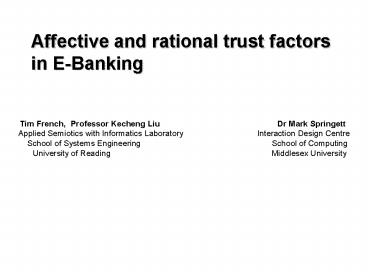Affective and rational trust factors - PowerPoint PPT Presentation
1 / 18
Title:
Affective and rational trust factors
Description:
Applied Semiotics with Informatics Laboratory Interaction Design Centre ... promised service delivery, and fears (mistrust) concerning security of credit ... – PowerPoint PPT presentation
Number of Views:71
Avg rating:3.0/5.0
Title: Affective and rational trust factors
1
Affective and rational trust factors in E-Banking
Tim French, Professor Kecheng Liu
Dr Mark Springett Applied Semiotics with
Informatics Laboratory
Interaction Design Centre School of
Systems Engineering
School of Computing
University of Reading
Middlesex University
2
What do we mean by E-Service trust?
Consumer trust viewpoint trust as a set of
fears and service expectations promised
service delivery, and fears (mistrust) concerning
security of credit-card details, infection of PC
with mal-ware, validity of guarantees
etc E-Service provider viewpoint trusted image
trusted security Presentation of a given
trusted e-business brand image, brand identity,
set of values, ethics, service level obligations,
standards, legal standards. Reliance on
intangible aspects of the site look-and-feel
and tangible security mediators SSL/TLS , secure
servers (French and Liu, 2005)
3
TANGIBLE/INTANGIBLE ASPECTS of TRUST...
security
privacy
TRUST
Security management policy, people...
intangibles
tangibles
- fears
- beliefs
- attitudes
- PKI
- firewalls
- digital certificates
- biometrics
- secure payments
- presentational issues
- working practices
- informal aspects,
4
Motivation for considering trust issues
Previous work has established that trust is
important and identified trust antecedents and
determinants at a coarse grained level - how to
add value to this work? - Model on-line trust
formation as a phenomena ..? - Deepen our
understanding of consumer on-line
trust perceptions through developing fine
-grained models of trust through
user-based studies -
5
does traditional shopping differ
frome-shopping.?
gt Traditional (e.g. car boot sale), mainly direct
/ tangibles Facial expressions,
discourse, tangibles (goods/currency/
signature on non-chip and PIN credit card),
normative risk /reward constraints.(price/gua
rantees) gt On-line shopping, mainly
intangibles Computer based signs
(presentation layer), passwords, virtual
identities, hidden layers (SSL client-server
protocol, X509 digital certificates,
proxies...
6
Theoretical underpinning.Morris meaning as
action paradigm (French and Liu, ALOIS 2005)
- Morris view of semiosis is that semiosis can be
determined from a subjects actions i.e. what they
understand can be determined by observing what
they do next (!) thus by observing user actions
including failure points we may better understand
trust determinants and trust semiosis - it is not that we should attempt to give
definition to a sign, rather establish the
situations in which something is recognised as a
sign - semiosis is not fundamentally about knowability,
but rather our ability to deal with signs via
behavioural (cognitive) responses that are
contextually bound
7
Maybe we need to probe the consumers/user
experience at a deeper level? (Figure adapted
from McCarthy Wright, 2004)
8
HOW? By seeking to observe users interacting with
sites at the THREE key stages ..of site
engagement
1 INITIAL ENCOUNTER WITH SITE Home-page -
branding, task initiators, pricing model,
service/product descriptors, cross-advertising,
cultural attractors, etc. Typically notions of
"trust" at this stage are transient lt 30 secs
(Sillence et al 2006) and appear to be influenced
by affective factors. METHODS CARD SORTING,
QUESTIONNAIRES 2 ENGAGEMENT WITH SITE As the
user actually seeks to engage (dynamically
navigates through) the site's state space model
notions of trust will typically be either
undermined or reinforced. METHODS OBSERVATION,
EXPERT HEURISTICS
9
Stages 3 4...
3 PURCHASE PHASE If the user is able and willing
to reach this (critical) point then at the point
of purchase, generic trust aspects of on-line
payments predominates user notions of trust
(e.g. trustworthiness of credit card usage on
the internet). 4 FULFILLMENT PHASE Delivery of
good and services needs to match user
expectations. If they do not then trust may well
be undermined.
10
How to probe B2C Trust? Semiotic using a tool-box
of techniques
Service Trust lifetime
Questionnaire?
Card sorting
State-models
Deconstructional analysis
11
Initial trust formation amongst consumers?
- investigation of trust formation using 40
subjects aged 25-40 yrs. - The subjects were exposed to a set of cards
each of which was a screen image of a well known
UK E-Banking site - The subjects were asked to carry out the
following experimental protocol
12
Experimental protocol aim to probe initial
(home-page) level trust
- Subjects asked to sort cards into self-chosen
categories in the context of trust - Subjects were asked to rank cards in order of
preference for each self-chosen criteria - Subjects were asked to identify any signs of
trust embedded within each site and to rate
these. - Subjects were also asked questions about their
previous exposure to the internet, E-Banking and
risk profile
13
E-Banking study 2006
14
Sites used cont.
15
Results
16
(No Transcript)
17
Instrumental
Affective
The graphic style is Too cartoonish, it isnt
bank-like
I cant see any security information
The security policy is not emphasised just
bunged into a menu with trivial stuff. It looks
like just another feature
Why are there pictures of flowers on a banking
site? It is kind of sinister.
The mortgage deals are glossily presented right
in your face, and then underneath Is the
sinister repossession warning
The navigation doesnt look helpful, it makes
me think they dont want me to find stuff
18
Affective Consequences of design decisions
- Users searching to establish and maintain trust
threshold - Deconstruct interface tokens for indications of
organisational integrity and attitude to
customers - Not simply looking for presence of tangible trust
factors but also mediation of the organisations
attitude and commitment - Mediated through intangible affective factors
and highly personal interpretations































